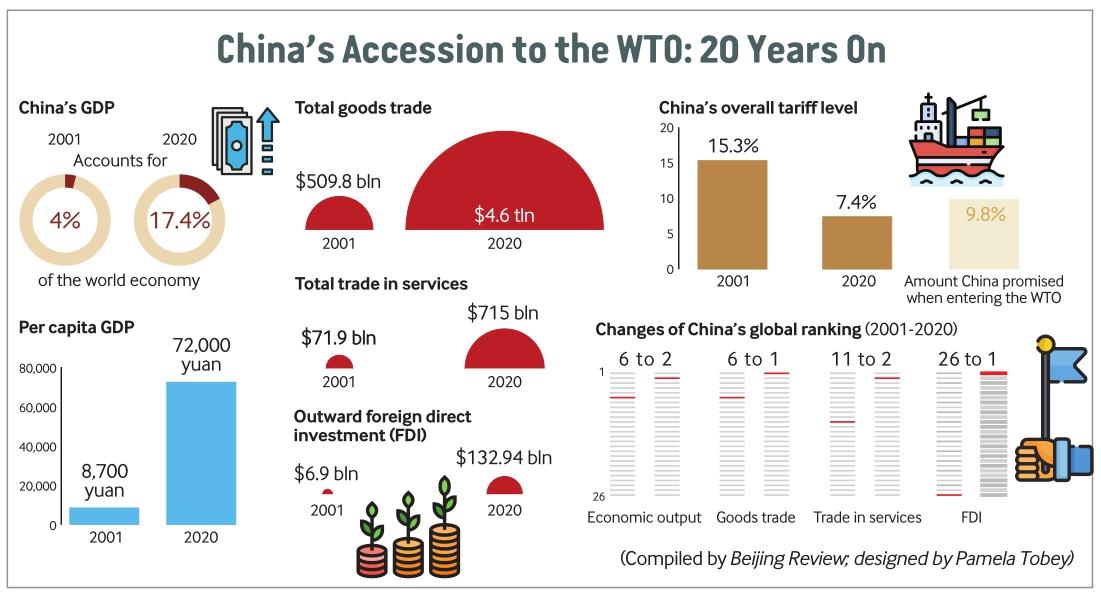GROWING TOGETHER
By Li Xiaoyang


Microsoft established the Microsoft China Research Institute in 1998, after first entering the Chinese market in 1992. By 2001, the institute had grown into Microsoft Research Asia, the U.S. tech companys largest overseas research facility. In the same year, China joined the World Trade Organization (WTO), despite controversies that the entry would pose challenges within the domestic market. Since then, two decades of success have proved both China and Microsoft have chosen the right paths.
“[Chinas] joining the WTO has only allowed and opened up more fair trade. Ultimately, were all part of a global and innovative marketplace,” Joe Bao, President of Microsoft China, told Beijing Review. According to Bao, Microsoft, which is the first multinational to bring its cloud services to China, aims to increase its overall service business 12 times through launching new data centers, and bringing more talent, digital transformation and innovation to the Chinese market.
“China has seen great changes since its accession to the WTO. Its GDP jumped from around 11 trillion yuan ($1.3 trillion) to over 100 trillion yuan ($15.7 trillion) between 2001 and 2020. It has become a magnet for foreign direct investment (FDI) by improving its business environment, and increased its investment in other countries,” Gu Baozhi, Director of the World Economy Research Institute at the Chinese Academy of International Trade and Economic Cooperation, told Beijing Review.
With a market that is expanding and improving, China has continued to embrace global businesses. Despite the COVID-19 pandemic, the Fourth China International Import Expo (CIIE) on November 5-10 saw $70.72 billion worth of intended deals signed.
Sprouting attraction
French luxury group LVMH has witnessed Chinas market growth and opening up since its WTO entry allowed global fashion brands to gain access to Chinese domestic retail business. Antonio Belloni, LVMH Group Managing Director, told a forum during this years CIIE that the company has seen the changes in Chinese consumerspreferences as well as its market rules over the past two decades. LVMH has made efforts to attract young people, the major group of luxury consumers in China, and developed online channels to make use of Chinas booming digital economy, according to him.
U.S.-headquartered technology and manufacturing company Honeywell International Inc. initiated its business in China in the 1970s and was one of the first multinationals to establish offices in Beijing. Steven Lien, President of Honeywell China and Aerospace Asia Pacific, told Beijing Review, China is Honeywells largest single market outside the U.S. as well as its largest growth market. With its core business perfectly aligned with local demands, such as its growing middle-income group, industrial digitalization and decarbonization, Honeywell is well-positioned to participate in Chinas high-quality development as the country further deepens its reform and opening up. As China further opens up to the world, Honeywell will also further increase investment, enhance local research and development (R&D) capabilities, and bring products developed in China to overseas markets, Lien added.
According to Lien, about half of Honeywells new R&D investment is directed toward products that improve environmental and social outcomes for customers. Chinas targets of peaking carbon emissions before 2030 and becoming carbon neutral before 2060 will bring more opportunities for the companys local cooperation.

Chinas opening-up efforts have increasingly received international recognition. Yves Reymond, head of the Economic, Financial and Commercial Section of Embassy of Switzerland in China, told Economic Information Daily that China-Switzerland economic and trade cooperation has expanded into many high value-added fields. The improvement of intellectual property protection in China has notably benefited Swiss medical and machinery enterprises.
Many foreign enterprises have pledged to contribute more to Chinas development. According to U.S. agriculture and food company Cargill, it will invest more than $78.5 billion in China to help improve farmers income and skill training, and enhance water resource conservation. Japanese cosmetics company Shiseido has established three R&D centers in China, saying the country is turning itself into a global innovation hub for cosmetics.
While the participation of foreign businesses has increased competition within the Chinese market, Chinese competitors are rising to meet the challenge. Their performance has also exceeded the expectations of many. In 2001, only 12 Chinese companies made it onto the Fortune Global 500 list. This number rises to 143 this year, and China is home to more companies on the list than any other country. The country has grown into a hub of global value chains and the largest manufacturing economy in the world.
Andrew Delios, a professor at the National University of Singapore Business School, told Beijing Review, the boom of Chinese enterprises and Chinas technological progress in recent years have weakened the competitiveness of foreign companies in the Chinese market compared with several decades ago. To do business in China, foreign enterprises need to understand the local business environment on its own merits, and drop assumptions and biases about how markets and societies should operate and have operated successfully in other parts of the world, he concluded.
According to Delios, the tremendous changes of the Chinese market can be attributed to its shifting emphasis from an economy founded on manufacturing and infrastructure construction to one focusing on innovation. The opportunities in the Chinese market now lie in its increasingly sophisticated consumers and tremendous wealth that drives consumption.
Efforts paying off
The WTO accession has allowed China to get involved in economic globalization through participating in global value chains and entering the global market, Gu said. The introduction of global funds, advanced technologies and management expertise has also enhanced the efficiency of its production and trade. With its industrial foundation developing over recent decades, China has seen notable technological progress and developed a large pool of experienced professionals.
To meet the requirements of WTO membership, central and local governments have revised or scrapped restrictions on trade and investment and strengthened intellectual property protection. Such reforms have driven the opening up of the Chinese market, according to Gu. Over the past two decades, China has fulfilled its commitments to the WTO, including lowering the overall tariff level and easing market access. Since it was introduced in 2013, authorities have repeatedly shortened the negative list that tables the areas out of bounds for foreign investors, and opened 21 pilot free trade zones. The first negative list for crossborder trade in services was unveiled earlier this year in the Hainan Province Free Trade Port.
According to Yu Miaojie, a professor at the National School of Development at Peking University, China has opened up more than 100 sectors as per WTO requirements, including more and more service sectors such as education, tourism, medical care and finance. Major industries like petroleum refining have also embraced foreign enterprises such as Royal Dutch Shell.
“China is the worlds top destination for FDI. While global enterprises benefit from its market openness, they have also helped meet Chinese consumersgrowing demands and improved their lives,” Yu told Beijing Review.
Future outlook
Facing challenges at home and abroad, China still has much to do to drive its own development and contribute to a more open global market. According to Gu, China needs to further reduce restrictions on foreign investment and open up the service and financial sectors. Reymond also suggested China work toward making its business environment more transparent and predictable, and facilitating business operation approval.
As WTO spokesperson Keith Rockwell told Xinhua News Agency, while China is by far the worlds largest exporter of goods and the second largest importer, its development in trade in services still features a lot of growth potential.

After two decades in the WTO, Chinas role has grown along with its market expansion. According to Rockwell, China has acted very similarly to other major WTO members and engaged actively in the organizations reform. It is leading in areas including e-commerce and development issues, and plays a key role in driving plurilateral negotiations.
In a meeting with Chinese Premier Li Keqiang via video link on December 4, WTO Director General Ngozi Okonjo-Iweala said China possesses significant experience from which other developing countries can learn a great deal. The WTO hopes to strengthen communication with China, jointly advance the reform of the WTO and make positive contributions to the healthy development of world trade, according to her.
Rising protectionism caused by the COVID-19 pandemic has challenged the status of the WTO and dragged down progress in multilateral trade in the digital, healthy and green economy sectors. WTO members need to support it on reforms and cooperate on global economic governance to deliver benefits to all, Gu said.
“China has been contributing to the multilateral trade system through promoting dispute settlement, launching the Belt and Road Initiative, hosting trade events like the CIIE, and supporting other developing countries by reducing tariffs on their exports,” he added. BR
(Ma Miaomiao contributed to this story)

